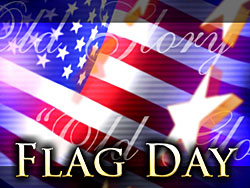Flag Day honors symbol of America
DAR information
The “Stars and Stripes” is a grand sight as it flutters in the breezes. We stand to honor that flag as it passes by in a parade. To salute the flag, people place their right hand over their heart. If the American flag is flown with other flags or banners, the American flag has the place of honor, and is placed to the right of a speaker podium.
The American flag has many names of honor. The “Red, White and Blue” hangs unseen on the bare landscape of the moon. “Old Glory” has been left on Mount Everest and in Antarctica to show that Americans were there. Soldiers raised the “American flag” on Mount Suribachi during World War II to be seen by all those fighting on Iwo Jima. The “Star-Spangled Banner” is the signature of the United States.
 Flags and banners have been used throughout history to unite groups of people and mark a gathering place. Flags have been important when armies are in battle or moving to a battle. A flag was raised high amid the battle and remained at the center of fighting. If the flag bearer dropped the flag because of wounds or death, another quickly raised the flag or would keep the flag from being captured or dishonored. Military leaders could watch and know where the battle was being fought and the location of the fighting men just by looking for a particular flag. As men advanced toward battle they would search for the flag’s location.
Flags and banners have been used throughout history to unite groups of people and mark a gathering place. Flags have been important when armies are in battle or moving to a battle. A flag was raised high amid the battle and remained at the center of fighting. If the flag bearer dropped the flag because of wounds or death, another quickly raised the flag or would keep the flag from being captured or dishonored. Military leaders could watch and know where the battle was being fought and the location of the fighting men just by looking for a particular flag. As men advanced toward battle they would search for the flag’s location.
The American flag would not be as striking in any other colors than red, white and blue. The red stands for courage, the white for purity and the blue vigilance. The design of the stars on the blue background in the upper left corner are a stark contrast and accent to the bold red and white stripes.
The flag of the United States of America we see today was not an original design, but a progression of design and meaning.
The original flag that the colonists had was 13 red and white stripes representing the original 13 colonies. That flag had a blue field in the upper left corner and within the blue canton was a red cross standing for Saint George of England, and a white cross representing Saint Andrew of Scotland. This was the accepted national flag on July 4, 1776, and was called the Grand Union Flag.
The revolution of the colonists against Great Britain demanded a change in the design of the flag. The 13 stripes remained on the flag but the British Union crosses in the blue canton were removed and replaced by 13 stars. Before the turn of the century, 1795, two new states were added to the original 13, and the flag’s design was enlarged to 15 stars and 15 stripes. This flag design was the one Francis Scott Key saw flying as bombs exploded over Fort McHenry at night, and “at dawn’s early light” was still flying over the fort, located in the harbor of Baltimore, Md., after a day and night of British bombardment. This was the flag Americans carried and raised during the War of 1812.
These 15 stars and 15 stripes were the nation’s flag from 1795-1818. Ohio joined the union in 1803, while four other states dis so by 1817. A flag with 20 stars and 20 stripes would have been a busy design, so it was proposed that the stripes remain at 13 to remember the 13 original colonies, while a five-pointed star be added in the blue canton area for each new state. New stars would be added on the first July 4 after a new state was added to the Union.
The 50-star flag with 13 stripes is the current flag of the United States of American and we honor that flag because it stands for all that we hold dear.
POSTED: 06/14/12 at 6:09 am. FILED UNDER: News







